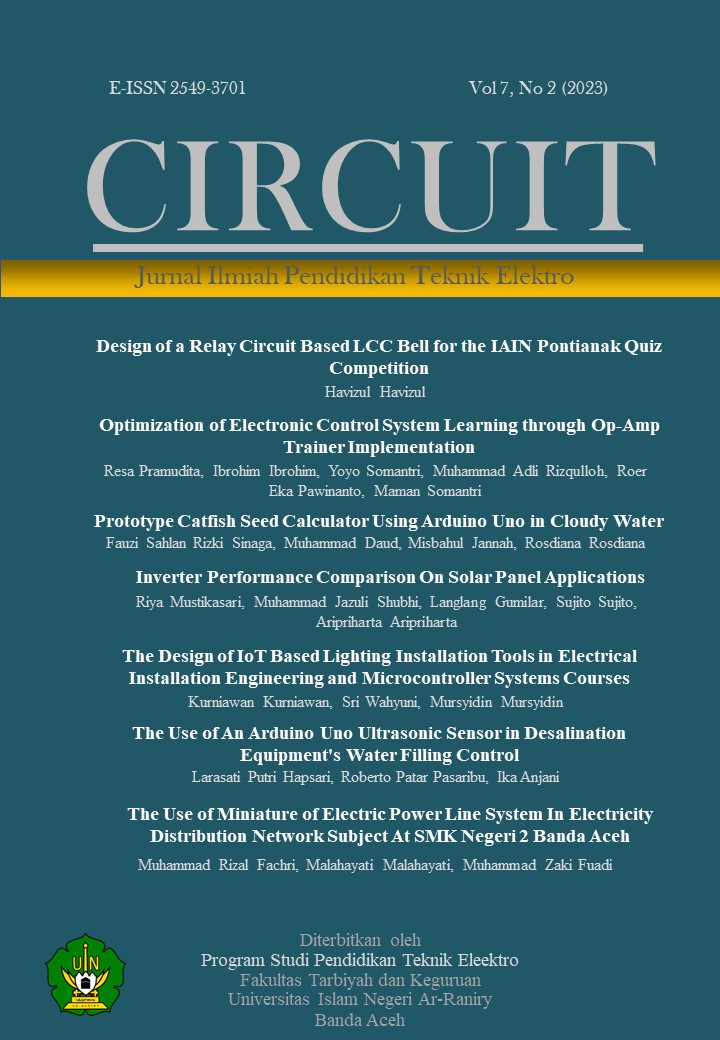The Use of Miniature of Electric Power Line System In Electricity Distribution Network Subject At SMK Negeri 2 Banda Aceh
DOI:
https://doi.org/10.22373/crc.v7i2.18308Keywords:
Miniature Use, Electric Power Distribution Network, Learning outcomesAbstract
Students need to learn about power distribution networks in order to comprehend how electricity is distributed from its source to its consumers. However, many students lack interest and have trouble understanding the theory of distribution systems. The goal of this study is to develop a tiny teaching tool that will be used in Class XI of the Electrical Network Engineering Department at SMK Negeri 2 Banda Aceh to teach the concept of power distribution networks. The objective is to validate and assess the merits of employing small media while instructing students about power distribution systems. Data are gathered using an experimental methodology in this study and through validation, observation, documentation, and testing. The study's findings suggest that making small media for power distribution systems is appropriate for teaching. When compared to the pre-test score of 61.65, the final test results demonstrate a remarkable improvement, with an average post-test score of 90.00. Therefore, SMK Negeri 2 Banda Aceh's use of teaching materials utilizing tiny power distribution systems is very effective in improving students' learning outcomes in the subject of power distribution systems.
References
Azriyenni. (2020). Transmisi Tenaga Listrik. Pekan baru: Taman Karya.
Badaruddin, a. (2015). peningkatan motivasi belajar siswa melalui konseling klasikal. cv abe kreatifindo.
Dinda, R A., Sadrina., Mursyidin. (2023). The High Accurate Automatic School Bell Controller Based On Arduino Uno DS 1307 l2C Real-Time Clock. Jurnal Teknik Mesin Mechanical Xplore, 4(1), p.17-26
Fajri, Abrar S., Lastya, Hari A., Malahayati. (2023). Pengaruh Penerapan Model Pembelajaran POGIL untuk Meningkatkan Pemahaman Peserta Didik Pada Kelas XI SMKS Mahyal Ulum Al-Aziziyah. Circuit: Jurnal Ilmiah Pendidikan Teknik Elektro, 7(1), p. 9-18
Ismail, M. I. (2020). Teknologi Pembelajaran Sebagai Media Pembelajaran. Makassar: Cendekia Publisher.
Jaya, I. M. (2020). Metode Penilitian Kuantitatif dan Kualitatif Teori,Penerapan, dan Riset Nyata. Yogyakarta: Anak Hebat Indonesia.
Sutianah, C. (2021). Belajar dan Pembelajaran. Jawa Timur: CV Penerbit Qiara.
Wardani, I. K. (2019). Pengaruh Penggunaan Miniatur Pada Materi Gaya Terhadap Hasil Belajar Siswa Kelas VIII SMPN 15 Mataram. Jurnal Pendidikan Mandala.
Widiarto, H. (2021). Transmisi Dan Distribusi. NTB: Pusat Pengembangan dan penelitian indonesia.
Wismaya, E. J. (2018). Pengembangan Media Pembelajaran Tiga Dimensi (Miniatur Kincir Air Pembangkit Listrik) untuk Materi Kelas IV Tema 2 Selalu Berhemat Energi. BASIC EDUCATION.
Downloads
Additional Files
Published
Issue
Section
License
Authors who publish in CIRCUIT: Jurnal Ilmiah Pendidikan Teknik Elektro agree to the following terms:
- Authors retain copyright and grant the journal right of first publication with the work licensed under a Creative Commons Attribution-ShareAlike 4.0 International License (CC BY-SA 4.0) that allows others to share and adapt the work with an acknowledgement of the authorship and initial publication in this journal
- Authors are able to enter into separate, additional contractual arrangements for the non-exclusive distribution of the journal's published version of the work (e.g., post it to an institutional repository or publish it in a book), with an acknowledgment of its initial publication in this journal.
- Authors are permitted and encouraged to post their work online (e.g., in institutional repositories or on their website) prior to and during the submission process, as it can lead to productive exchanges, as well as earlier and greater citation of published work. (See The Effect of Open Acces)

